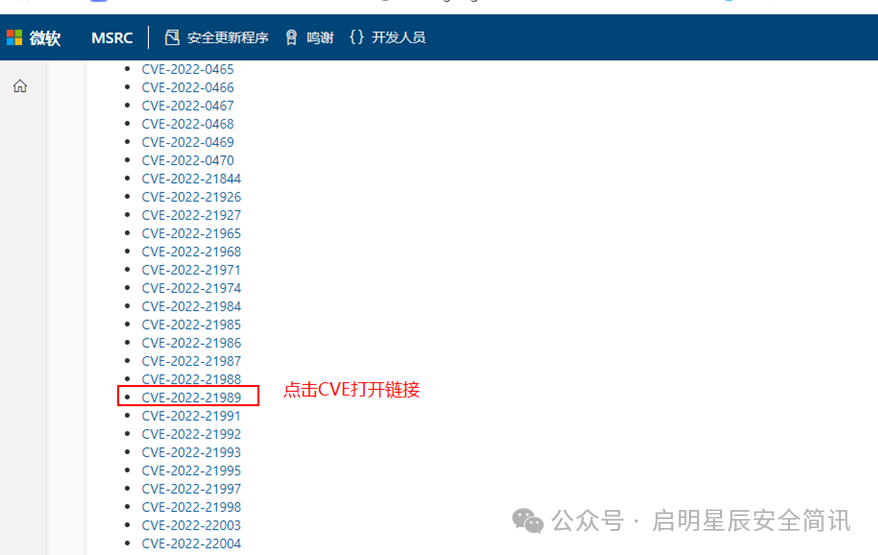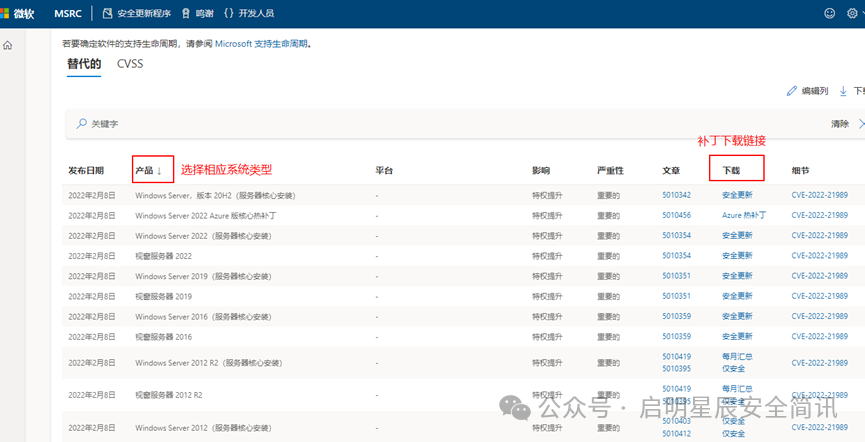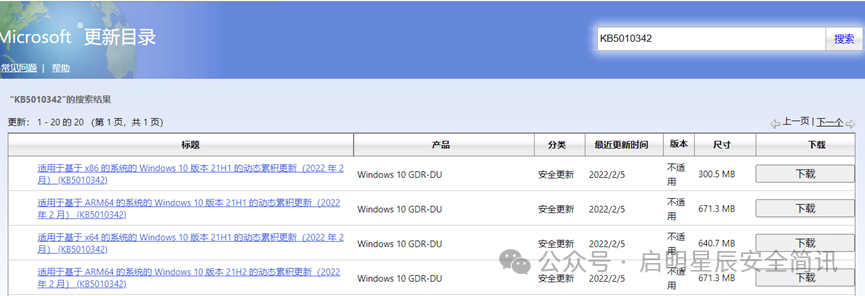【漏洞通告】微软8月多个安全漏洞
发布时间 2025-08-132025年8月13日,启明星辰集团VSRC监测到微软发布了8月安全更新,本次更新修复了111个漏洞,涵盖特权提升、远程代码执行、信息泄露等多种漏洞类型。漏洞级别分布如下:17个严重级别漏洞,91个重要级别漏洞,2个中危级别漏洞,1个低危级别漏洞(漏洞级别依据微软官方数据)。
其中,9个漏洞被微软标记为“更可能被利用”及“检测利用情形”,表明这些漏洞存在较高的利用风险,建议优先修复以降低潜在安全威胁。
CVE-ID | CVE 标题 | 漏洞级别 |
CVE-2025-49743 | Windows 图形组件特权提升漏洞 | 重要 |
CVE-2025-50167 | Windows Hyper-V 特权提升漏洞 | 重要 |
CVE-2025-50168 | Win32k 特权提升漏洞 | 重要 |
CVE-2025-50177 | Microsoft 消息队列 (MSMQ) 远程代码执行漏洞 | 严重 |
CVE-2025-53132 | Win32k 特权提升漏洞 | 重要 |
CVE-2025-53147 | WinSock 的 Windows 辅助功能驱动程序特权提升漏洞 | 重要 |
CVE-2025-53156 | Windows 存储端口驱动程序信息泄露漏洞 | 重要 |
CVE-2025-53778 | Windows NTLM 特权提升漏洞 | 严重 |
CVE-2025-53786 | Microsoft Exchange Server 混合部署特权提升漏洞 | 重要 |
微软8月更新修复的完整漏洞列表如下:
CVE-ID | CVE 标题 | 漏洞级别 |
CVE-2025-24999 | Microsoft SQL Server 特权提升漏洞 | 重要 |
CVE-2025-25005 | Microsoft Exchange Server 篡改漏洞 | 重要 |
CVE-2025-25006 | Microsoft Exchange Server 欺骗漏洞 | 重要 |
CVE-2025-25007 | Microsoft Exchange Server 欺骗漏洞 | 重要 |
CVE-2025-33051 | Microsoft Exchange Server 信息泄露漏洞 | 重要 |
CVE-2025-47954 | Microsoft SQL Server 特权提升漏洞 | 重要 |
CVE-2025-48807 | Windows Hyper-V 远程执行代码漏洞 | 严重 |
CVE-2025-49707 | Azure Virtual Machines Spoofing Vulnerability | 严重 |
CVE-2025-49712 | Microsoft SharePoint 远程执行代码漏洞 | 重要 |
CVE-2025-49736 | Android 版 Microsoft Edge(基于 Chromium)欺骗漏洞 | 中 |
CVE-2025-49743 | Windows 图形组件特权提升漏洞 | 重要 |
CVE-2025-49745 | Microsoft Dynamics 365(本地)跨站点脚本漏洞 | 重要 |
CVE-2025-49751 | Windows Hyper-V 拒绝服务漏洞 | 重要 |
CVE-2025-49755 | Android 版 Microsoft Edge(基于 Chromium)欺骗漏洞 | 低 |
CVE-2025-49757 | Windows 路由和远程访问服务 (RRAS) 远程代码执行漏洞 | 重要 |
CVE-2025-49758 | Microsoft SQL Server 特权提升漏洞 | 重要 |
CVE-2025-49759 | Microsoft SQL Server 特权提升漏洞 | 重要 |
CVE-2025-49761 | Windows 内核特权提升漏洞 | 重要 |
CVE-2025-49762 | WinSock 的 Windows 辅助功能驱动程序特权提升漏洞 | 重要 |
CVE-2025-50153 | 桌面窗口管理器特权提升漏洞 | 重要 |
CVE-2025-50154 | Microsoft Windows 文件资源管理器欺骗漏洞 | 重要 |
CVE-2025-50155 | Windows 推送通知应用程序特权提升漏洞 | 重要 |
CVE-2025-50156 | Windows 路由和远程访问服务 (RRAS) 信息披露漏洞 | 重要 |
CVE-2025-50157 | Windows 路由和远程访问服务 (RRAS) 信息披露漏洞 | 重要 |
CVE-2025-50158 | Windows NTFS 信息泄露漏洞 | 重要 |
CVE-2025-50159 | 远程访问点对点协议(PPP) EAP-TLS特权提升漏洞 | 重要 |
CVE-2025-50160 | Windows 路由和远程访问服务 (RRAS) 远程代码执行漏洞 | 重要 |
CVE-2025-50161 | Win32k 特权提升漏洞 | 重要 |
CVE-2025-50162 | Windows 路由和远程访问服务 (RRAS) 远程代码执行漏洞 | 重要 |
CVE-2025-50163 | Windows 路由和远程访问服务 (RRAS) 远程代码执行漏洞 | 重要 |
CVE-2025-50164 | Windows 路由和远程访问服务 (RRAS) 远程代码执行漏洞 | 重要 |
CVE-2025-50165 | Windows 图形组件远程执行代码漏洞 | 严重 |
CVE-2025-50166 | Windows 分布式事务处理协调器 (MSDTC) 信息泄露漏洞 | 重要 |
CVE-2025-50167 | Windows Hyper-V 特权提升漏洞 | 重要 |
CVE-2025-50168 | Win32k 特权提升漏洞 | 重要 |
CVE-2025-50169 | Windows SMB 远程执行代码漏洞 | 重要 |
CVE-2025-50170 | Windows Cloud Files Mini Filter Driver 特权提升漏洞 | 重要 |
CVE-2025-50171 | 远程桌面欺骗漏洞 | 重要 |
CVE-2025-50172 | DirectX 图形内核拒绝服务漏洞 | 重要 |
CVE-2025-50173 | Windows Installer 特权提升漏洞 | 重要 |
CVE-2025-50176 | DirectX 图形内核远程代码执行漏洞 | 严重 |
CVE-2025-50177 | Microsoft 消息队列 (MSMQ) 远程代码执行漏洞 | 严重 |
CVE-2025-53131 | Windows Media 远程执行代码漏洞 | 重要 |
CVE-2025-53132 | Win32k 特权提升漏洞 | 重要 |
CVE-2025-53133 | Windows PrintWorkflowUserSvc 特权提升漏洞 | 重要 |
CVE-2025-53134 | WinSock 的 Windows 辅助功能驱动程序特权提升漏洞 | 重要 |
CVE-2025-53135 | DirectX 图形内核特权提升漏洞 | 重要 |
CVE-2025-53136 | NT OS 内核信息泄露漏洞 | 重要 |
CVE-2025-53137 | WinSock 的 Windows 辅助功能驱动程序特权提升漏洞 | 重要 |
CVE-2025-53138 | Windows 路由和远程访问服务 (RRAS) 信息披露漏洞 | 重要 |
CVE-2025-53140 | Windows 内核事务管理器特权提升漏洞 | 重要 |
CVE-2025-53141 | WinSock 的 Windows 辅助功能驱动程序特权提升漏洞 | 重要 |
CVE-2025-53142 | Microsoft 代理文件系统特权提升漏洞 | 重要 |
CVE-2025-53143 | Microsoft 消息队列 (MSMQ) 远程代码执行漏洞 | 重要 |
CVE-2025-53144 | Microsoft 消息队列 (MSMQ) 远程代码执行漏洞 | 重要 |
CVE-2025-53145 | Microsoft 消息队列 (MSMQ) 远程代码执行漏洞 | 重要 |
CVE-2025-53147 | WinSock 的 Windows 辅助功能驱动程序特权提升漏洞 | 重要 |
CVE-2025-53148 | Windows 路由和远程访问服务 (RRAS) 信息披露漏洞 | 重要 |
CVE-2025-53149 | Kernel Streaming WOW Thunk 服务驱动程序特权提升漏洞 | 重要 |
CVE-2025-53151 | Windows 内核特权提升漏洞 | 重要 |
CVE-2025-53152 | 桌面窗口管理器远程代码执行漏洞 | 重要 |
CVE-2025-53153 | Windows 路由和远程访问服务 (RRAS) 信息披露漏洞 | 重要 |
CVE-2025-53154 | WinSock 的 Windows 辅助功能驱动程序特权提升漏洞 | 重要 |
CVE-2025-53155 | Windows Hyper-V 特权提升漏洞 | 重要 |
CVE-2025-53156 | Windows 存储端口驱动程序信息泄露漏洞 | 重要 |
CVE-2025-53716 | 本地安全认证子系统服务(LSASS) 拒绝服务漏洞 | 重要 |
CVE-2025-53718 | WinSock 的 Windows 辅助功能驱动程序特权提升漏洞 | 重要 |
CVE-2025-53719 | Windows 路由和远程访问服务 (RRAS) 信息披露漏洞 | 重要 |
CVE-2025-53720 | Windows 路由和远程访问服务 (RRAS) 远程代码执行漏洞 | 重要 |
CVE-2025-53721 | Windows 互联设备平台服务特权提升漏洞 | 重要 |
CVE-2025-53722 | Windows 远程桌面服务拒绝服务漏洞 | 重要 |
CVE-2025-53723 | Windows Hyper-V 特权提升漏洞 | 重要 |
CVE-2025-53724 | Windows 推送通知应用程序特权提升漏洞 | 重要 |
CVE-2025-53725 | Windows 推送通知应用程序特权提升漏洞 | 重要 |
CVE-2025-53726 | Windows 推送通知应用程序特权提升漏洞 | 重要 |
CVE-2025-53727 | Microsoft SQL Server 特权提升漏洞 | 重要 |
CVE-2025-53728 | Microsoft Dynamics 365(本地)信息泄露漏洞 | 重要 |
CVE-2025-53729 | Microsoft Azure 文件同步特权提升漏洞 | 重要 |
CVE-2025-53730 | Microsoft Office Visio 远程执行代码漏洞 | 重要 |
CVE-2025-53731 | Microsoft Office 远程执行代码漏洞 | 严重 |
CVE-2025-53732 | Microsoft Office 远程执行代码漏洞 | 重要 |
CVE-2025-53733 | Microsoft Word 远程执行代码漏洞 | 严重 |
CVE-2025-53734 | Microsoft Office Visio 远程执行代码漏洞 | 重要 |
CVE-2025-53735 | Microsoft Excel 远程执行代码漏洞 | 重要 |
CVE-2025-53736 | Microsoft Word 信息泄露漏洞 | 重要 |
CVE-2025-53737 | Microsoft Excel 远程执行代码漏洞 | 重要 |
CVE-2025-53738 | Microsoft Word 远程执行代码漏洞 | 重要 |
CVE-2025-53739 | Microsoft Excel 远程执行代码漏洞 | 重要 |
CVE-2025-53740 | Microsoft Office 远程执行代码漏洞 | 严重 |
CVE-2025-53741 | Microsoft Excel 远程执行代码漏洞 | 重要 |
CVE-2025-53759 | Microsoft Excel 远程执行代码漏洞 | 重要 |
CVE-2025-53760 | Microsoft SharePoint 特权提升漏洞 | 重要 |
CVE-2025-53761 | Microsoft PowerPoint 远程代码执行漏洞 | 重要 |
CVE-2025-53765 | Azure Stack Hub 信息泄露漏洞 | 重要 |
CVE-2025-53766 | GDI 远程执行代码漏洞 | 严重 |
CVE-2025-53767 | Azure OpenAI 特权提升漏洞 | 严重 |
CVE-2025-53769 | Windows 安全应用程序欺骗漏洞 | 重要 |
CVE-2025-53772 | Web 部署远程代码执行漏洞 | 重要 |
CVE-2025-53773 | GitHub Copilot 和 Visual Studio 远程代码执行漏洞 | 重要 |
CVE-2025-53774 | Microsoft 365 Copilot BizChat 信息泄露漏洞 | 严重 |
CVE-2025-53778 | Windows NTLM 特权提升漏洞 | 严重 |
CVE-2025-53779 | Windows Kerberos 特权提升漏洞 | 中 |
CVE-2025-53781 | Azure Virtual Machines Information Disclosure Vulnerability | 严重 |
CVE-2025-53783 | Microsoft Teams 远程代码执行漏洞 | 重要 |
CVE-2025-53784 | Microsoft Word 远程执行代码漏洞 | 严重 |
CVE-2025-53786 | Microsoft Exchange Server 混合部署特权提升漏洞 | 重要 |
CVE-2025-53787 | Microsoft 365 Copilot BizChat 信息泄露漏洞 | 严重 |
CVE-2025-53788 | Windows Subsystem for Linux (WSL2) 内核特权提升漏洞 | 重要 |
CVE-2025-53789 | Windows StateRepository API 服务器文件特权提升漏洞 | 重要 |
CVE-2025-53792 | Azure 门户特权提升漏洞 | 严重 |
CVE-2025-53793 | Azure Stack Hub 信息泄露漏洞 | 严重 |
二、影响范围
受影响的产品/功能/服务/组件包括:
SQL Server
Microsoft Exchange Server
Role: Windows Hyper-V
Azure Virtual Machines
Microsoft Office SharePoint
Microsoft Edge for Android
Microsoft Graphics Component
Microsoft Dynamics 365 (on-premises)
Windows Routing and Remote Access Service (RRAS)
Windows Kernel
Windows Ancillary Function Driver for WinSock
Desktop Windows Manager
Windows File Explorer
Windows Push Notifications
Windows NTFS
Remote Access Point-to-Point Protocol (PPP) EAP-TLS
Windows Win32K - GRFX
Windows Distributed Transaction Coordinator
Windows Win32K - ICOMP
Windows SMB
Windows Cloud Files Mini Filter Driver
Remote Desktop Server
Windows DirectX
Windows Installer
Graphics Kernel
Windows Message Queuing
Windows Media
Windows PrintWorkflowUserSvc
Windows NT OS Kernel
Kernel Transaction Manager
Microsoft Brokering File System
Kernel Streaming WOW Thunk Service Driver
Storage Port Driver
Windows Local Security Authority Subsystem Service (LSASS)
Windows Connected Devices Platform Service
Windows Remote Desktop Services
Azure File Sync
Microsoft Office Visio
Microsoft Office
Microsoft Office Word
Microsoft Office Excel
Microsoft Office PowerPoint
Azure Stack
Windows GDI+
Azure OpenAI
Windows Security App
Web Deploy
GitHub Copilot and Visual Studio
Microsoft 365 Copilot's Business Chat
Windows NTLM
Windows Kerberos
Microsoft Teams
Windows Subsystem for Linux
Windows StateRepository API
Azure Portal
三、安全措施
3.1 升级版本
目前微软已发布相关安全更新,建议受影响的用户尽快修复。
(一)Windows Update自动更新
Microsoft Update默认启用,当系统检测到可用更新时,将会自动下载更新并在下一次启动时安装。也可选择通过以下步骤手动进行更新:
1、点击“开始菜单”或按Windows快捷键,点击进入“设置”
2、选择“更新和安全”,进入“Windows更新”(Windows 8、Windows 8.1、Windows Server 2012以及Windows Server 2012 R2可通过控制面板进入“Windows更新”,具体步骤为“控制面板”->“系统和安全”->“Windows更新”)
3、选择“检查更新”,等待系统自动检查并下载可用更新。
4、更新完成后重启计算机,可通过进入“Windows更新”->“查看更新历史记录”查看是否成功安装了更新。对于没有成功安装的更新,可以点击该更新名称进入微软官方更新描述链接,点击最新的SSU名称并在新链接中点击“Microsoft 更新目录”,然后在新链接中选择适用于目标系统的补丁进行下载并安装。
(二)手动安装更新
Microsoft官方下载相应补丁进行更新。
2025年8月安全更新下载链接:
https://msrc.microsoft.com/update-guide/releaseNote/2025-Aug
补丁下载示例(参考):
1.打开上述下载链接,点击漏洞列表中要修复的CVE链接。

例1:微软漏洞列表(示例)
2.在微软公告页面底部左侧【产品】列选择相应的系统类型,点击右侧【下载】列打开补丁下载链接。

例2:CVE-2022-21989补丁下载示例
3.点击【安全更新】,打开补丁下载页面,下载相应补丁并进行安装。

例3:补丁下载界面
4.安装完成后重启计算机。
3.2 临时措施
暂无。
3.3 通用建议
• 定期更新系统补丁,减少系统漏洞,提升服务器的安全性。
• 加强系统和网络的访问控制,修改防火墙策略,关闭非必要的应用端口或服务,减少将危险服务(如SSH、RDP等)暴露到公网,减少攻击面。
• 使用企业级安全产品,提升企业的网络安全性能。
• 加强系统用户和权限管理,启用多因素认证机制和最小权限原则,用户和软件权限应保持在最低限度。
• 启用强密码策略并设置为定期修改。
3.4 参考链接
https://msrc.microsoft.com/update-guide/releaseNote/2025-Aug




 京公网安备11010802024551号
京公网安备11010802024551号